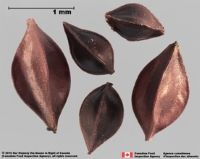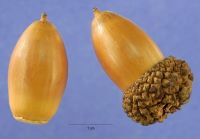Content is from Kirkbride et al. 2006Kirkbride et al. 2006:
Kirkbride JH, Jr, Gunn CR, and Dallwitz MJ. 2006. Family guide for fruits and seeds, vers. 1.0. Accessed September 2020-January 2022. URL: https://nt.ars-grin.gov/seedsfruits/keys/frsdfam/index.cfm ., without modification.
Updates are forthcoming.
Fruits: Pistil(s) 1; 1-pistillate. Fruit anthocarpanthocarp:
simple or compound and including some tissue of non-ovarian origin (accessory tissue) ; simple, or compound; diclesium; catoclesium; without persistent central column; crowned by sepalssepal:
; simple, or compound; diclesium; catoclesium; without persistent central column; crowned by sepalssepal:
a member of the outer envelope of a flower (calyx) , or perianthperianth:
, or perianthperianth:
collective term for calyx and corolla of a flower
 (could be calyxcalyx:
(could be calyxcalyx:
the outer whorl of the perianth; all the sepals of a flower or perianthperianth:
or perianthperianth:
collective term for calyx and corolla of a flower
 depending on author); not within accessory organ(s); with 2-carpellate; with carpels united; with carpels remaining united at maturity; without sterilesterile:
depending on author); not within accessory organ(s); with 2-carpellate; with carpels united; with carpels remaining united at maturity; without sterilesterile:
lacking male and/or female reproductive parts; also, not producing fruit or seed
 carpels; apexapex:
carpels; apexapex:
the point farthest from the point of attachment, or the "tip" of an organ not beaked; indehiscentindehiscent:
not beaked; indehiscentindehiscent:
not opening on its own, as in a fruit
 . Epicarpepicarp:
. Epicarpepicarp:
outer layer of fruit wall or pericarp, if divided into layers; note here used synonymously with exocarp durable; without armature; without wing(s); without apicalapical:
durable; without armature; without wing(s); without apicalapical:
at or pertaining to the end of the seed or fruit distal from its point of attachment (i.e., base)
respiratory hole. Endocarpendocarp:
the inner layer of the pericarp, if divided into layers present; not separating from exocarpexocarp:
present; not separating from exocarpexocarp:
outer layer of fruit wall or pericarp, if divided into layers; note here used synonymously with epicarp ; thin; not splitting into 1-seeded pyrenes; smooth; without wing; without operculumoperculum:
; thin; not splitting into 1-seeded pyrenes; smooth; without wing; without operculumoperculum:
a dehiscent cap (or lid) of a seed or fruit that opens during germination or dehiscence ; without secretory cavities; without mechanism for seedling escape; without longitudinallongitudinal:
; without secretory cavities; without mechanism for seedling escape; without longitudinallongitudinal:
of or relating to length or the lengthwise dimension
ridges. Funiculusfuniculus:
(alt. funicle) stalk connecting the ovule (later seed) to the ovary (later fruit) placenta short; short without seed bearing hookswith hooks:
short; short without seed bearing hookswith hooks:
bristles or spines with curved or backwards pointing tips, or with secondary bristles along their length (retinacula); not persisting in fruit after seed shed.
(retinacula); not persisting in fruit after seed shed.
Seeds: Arilaril:
(broad sense) appendicular structure that wholly or partly envelops a seed and is produced from or a modification of the funicle, raphe, or outer integument; usually fleshy or pulpy, sometimes spongy or tufted-capillate, often brightly colored absent. Seed larger than minute; angularangular:
absent. Seed larger than minute; angularangular:
2D shape—having sides that meet at acute or obtuse angles
, or circularcircular:
(of embryo) linear embryo is curved into an "O" shape , or irregular; in transection compressedcompressed:
, or irregular; in transection compressedcompressed:
flattened; in grasses, used to denote compression (not necessarily flattened) either laterally or dorsiventrally
, or tereteterete:
approximately circular in cross section; width and thickness approximately equal
 ; not bowl shaped; not nutlike; without winglike beakbeak:
; not bowl shaped; not nutlike; without winglike beakbeak:
a usually firm, terminal appendage, sometimes tapered ; without caudatecaudate:
; without caudatecaudate:
tapering to a long, tail-like appendage appendage(s); at maturity with food reserves; with endosperm; without canavanine. Sarcotestasarcotesta:
appendage(s); at maturity with food reserves; with endosperm; without canavanine. Sarcotestasarcotesta:
pulpy or fleshy outer layer of the seed coat, simulates aril absent. Testatesta:
absent. Testatesta:
seed coat
 present, or absent; adnate to epicarpepicarp:
present, or absent; adnate to epicarpepicarp:
outer layer of fruit wall or pericarp, if divided into layers; note here used synonymously with exocarp (hardly separable from pericarppericarp:
(hardly separable from pericarppericarp:
fruit wall or fruit coat
); without embryo surrounded and capped by viscid tissue; without fleshy or leatheryleathery:
texture—moderately thick, tough, and very pliable
layer over hard layer; surface smooth (assumed); without crease or line separating cotyledons from hypocotyl-radicle; without notch along margin where cotyledons from hypocotyl-radicle tip approach each other; without glands; without bristles; without wings; without collar; without operculumoperculum:
a dehiscent cap (or lid) of a seed or fruit that opens during germination or dehiscence ; colored; monochrome; not becoming mucilaginousmucilaginous:
; colored; monochrome; not becoming mucilaginousmucilaginous:
resembling mucilage; moist and sticky
when wetted; surrounding food reserve. Rapheraphe:
a ridge or seam on the seed coat, formed by the portion of the funiculus united to the ovule wall in longitudinally curved ovules conspicuous (longitudinallongitudinal:
conspicuous (longitudinallongitudinal:
of or relating to length or the lengthwise dimension
). Endosperm development cellular; copious to scant; fleshy; smooth; with oils; without fatty acid containing cyclopropene; without apicalapical:
at or pertaining to the end of the seed or fruit distal from its point of attachment (i.e., base)
lobes; without chlorophyll; without isodiametric faceted surface; without odor. Embryo differentiated from food reserve; well developed; 1 per seed; partially filling testatesta:
seed coat
 (with food reserve); 0.75–0.9 times the length of food reserve; at one end of seed not extending into a depression or cup; axileaxile:
(with food reserve); 0.75–0.9 times the length of food reserve; at one end of seed not extending into a depression or cup; axileaxile:
on or of the axis
and centric; linearlinear:
(shape) long, narrow, and uniform in width; (of embryo) embryo is straight and much longer than wide ; straight; with cotyledons gradually connected to hypocotyl-radicle; without coleorhiza; without simmondsin; without stomata; not green; with 2 or more cotyledons. Cotyledons 2; well developed; 0.25–0.3 times length of embryo; as wide as hypocotyl-radicle; smooth; with apicesapex:
; straight; with cotyledons gradually connected to hypocotyl-radicle; without coleorhiza; without simmondsin; without stomata; not green; with 2 or more cotyledons. Cotyledons 2; well developed; 0.25–0.3 times length of embryo; as wide as hypocotyl-radicle; smooth; with apicesapex:
the point farthest from the point of attachment, or the "tip" of an organ entire; with margins separate; equal in size; not punctatepunctate:
entire; with margins separate; equal in size; not punctatepunctate:
surface relief—dotted with pits or with translucent, sunken glands or with colored dots, similar to pitted dotted. Hypocotyl-radicle well developed; not thickened.
dotted. Hypocotyl-radicle well developed; not thickened.
 or a nutnut:
or a nutnut: .
.
General references: Baillon, H.E. 1866–95. Histoire des plantes, 13 vols. Hachette & Co., Paris, Cronquist, A. 1981. An integrated system of classification of flowering plants, 1,262 p. Columbia University Press, New York, Engler, A. 1900–1953. Das Pflanzenreich, nos. 1–107. Facsimile edition. Engelmann-Cramer, Weinheim, Engler, A. & K. Prantl. 1924 and onward. Die Natürlichen Pflanzenfamilimien. W. Engelman, Leipzig, Goldberg, A. 1986 (dicots) & 1989 (monocots). Classification, evolution, and phylogeny of the familes of Dicotyledons. Smithsonian Contr. Bot. 58 for dicots (314 pp.) & 71 for monocots (74 pp.). [Goldberg's illustrations are reproduced from older publications and these should be consulted], Gunn, C.R., J.H. Wiersema, C.A. Ritchie, & J.H. Kirkbride, Jr. 1992 & amendments. Families and genera of Spermatophytes recognized by the Agricultural Research Service. Techn. Bull. U.S.D.A. 1796:1–500, LeMaout, E. & J. Decaisne. 1876. A general system of botany, 1,065 p. Longmans, Green, & Co., London, and Spjut, R.W. 1994. A systematic treatment of fruit types. Mem. New York Bot. Gard. 70:1–182.